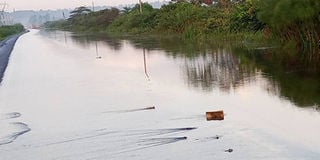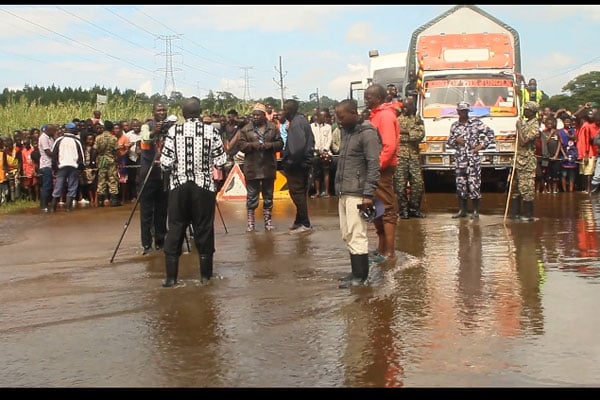Uganda braces for extreme weather events

The flooded section of Kampala-Masaka highway at Katonga. PHOTOS/ UNRA
Flash flooding in parts of Uganda, following torrential rain and the 50 percent chance of an El Niño coming to Uganda in the second half of 2023, has left weather experts in the country painting doomsday scenarios.
The Uganda National Meteorological Authority (UNMA) has warned of a possible outbreak of malaria and other waterborne diseases endemic in the country such as cholera and bilharzia. Health officials have been urged to be on the lookout for another type of flood—that of patients.
Already, the Health ministry has embarked on a “free mosquito net campaign.” Locals have also been advised to clear any breeding grounds for mosquitoes such as floodplains along stream and river banks.
Releasing the monthly rainfall update for May, Mr Bob Alex Ogwang—UNMA’s acting executive director—revealed that there is “a slight tendency to above normal rainfall during the forecast period.”
Mr Ogwang also revealed that most parts of the country grappled with “wetter conditions” in April.
The highest amount of rainfall was recorded at Kamenyamigo station in Lwengo District, with a total of 512 millimetres (mm).
This was followed by Entebbe Water Resource Department in Wakiso District, with an amount of 493.1mm, Kagulu S/C in Buyende District, with 459.7mm, Kituuza CRU Station in Mukono District, with 411.5mm.
The lowest amount was registered at Butiaba station in Buliisa District, with 29.9mm. Elsewhere, Lwampanga Station in Nakasongola District mustered just 86.2mm. Rainfall is measured using a rain gauge that typically takes stock of precipitation in millimetres in height collected during a given period.
In terms of temporal rainfall distribution or the number of days with rainfall activity, Kagulu S/C Station experienced the highest number, with an observation of 22 days in the month.
The May rains have left a trail of destruction in the country. Violent winds, floods, mudslides, hailstorms, and thunderstorms have claimed lives and destroyed a number of public infrastructure.
Incidents have been reported in Rukungiri District where flash floods, among others, claimed three lives, destroyed crops in the districts of Oyam and Bulambuli and displaced residents in Ntoroko, Kasese, and Butaleja.
While delivering a flash update this week, Ms Esther Davinia Anyakun—the junior Disaster Preparedness and Refugees minister—urged “communities staying in floods and landslide-prone areas to relocate to safer zones to avoid re-occurrence of disasters which have claimed many people.”
She added: “People must understand that these areas tend to be dangerous during the rainy season after slope failures.”
A number of districts are grappling with internally-displaced persons due to extreme weather events. These include Kampala, Wakiso, Masaka, Kayunga, Amolatar, Apac, Nakasongola, Bulisa, Ntoroko, and Kasese.
UNMA’s forecasts indicate that there will be average to enhanced rainfall during the MAM (March, April, May) period, with chances of the latter highly probable in the eastern and north eastern regions. Equally affected is the southern sector of the country. This includes districts in southwestern, western and around the Lake Victoria basin.
Nearly 50 districts from the sub-regions of Lango, Teso, Karamoja, Bugisu, Bukedi, Sebei, Busoga, Kigezi, and Bunyoro are high-risk for water logging, wind storms and landslides during the MAM period. With many gardens expected to be impacted negatively by water logging, the Office of the Prime Minister is readying itself for a food crisis.
“As a Ministry of Disaster Preparedness in collaboration with UNMA, we will intensify the dissemination of early warning messages and provide updates through early warning bulletins, talkshows, social media platforms and press statements that will be issued from time to time,” Ms Anyakun revealed.
The El Niño outlook, meanwhile, remains at what UNMA describes as an “El Niño watch.”
Mr Ogwang said this means that while the El Niño-Southern Oscillation (ENSO) is currently neutral, there is approximately a 50 percent chance of El Niño developing in the second season of 2023.
El Niño watch, he added, is not a guarantee that El Niño will occur; rather an indication that some of the typical pre cursors are currently in place.
The ENSO is a cycle of warm and cold sea surface temperature that can create nightmarish conditions by either increasing rainfall or raising temperatures.




